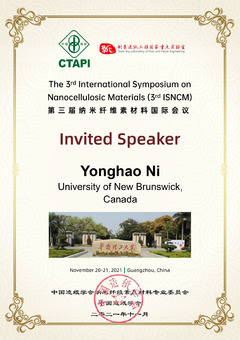Nanocellulose as templates to prepare composite solid-state electrolytes and their lithium-ion transport mechanism
ID:103
View Protection:PRIVATE
Updated Time:2021-11-16 10:07:09
Hits:1113
Invited speech
Abstract
ABSTRACT
Composite solid-state electrolytes (CSEs) with high ionic conductivity and low interfacial resistance have been pursued for next-generation high energy density all solid-state lithium-ion batteries (ASSLIBs). The interaction between the inorganic ceramic electrolyte with continuous framework and the polymer electrolyte can simultaneously exhibit high ionic conductivity and flexibility. Herein, a flexible, high ion conductive, and electrochemically stable CSE, consisting of three-dimensional (3D) interconnected Li7La3Zr2O12 (LLZO) framework and poly (ethylene oxide) - LiC2F6NO4S2 (PEO-LiTFSI) polymer, has been successfully prepared using lignosulfonate/ cellulose nanofiber (LS-CNF) networks as a bio-template. The 3D porous LS-CNF network effectively promotes the adsorption and dispersion of LLZO precursors, which, upon calcination, leads to the formation of interconnected LLZO framework with homogeneous and small ceramic branches, thus offering abundant ion conductance pathways. The as-prepared CSE shows very high ionic conductivity of 1.37×10-4 S·cm-1 and a high lithium-ion transference number of 0.59 at 30°C with a wide electrochemical stability window of 5.4 V vs. Li/Li+. The assembled Li/LiFePO4 battery exhibits a high initial capacity of 134 mAh·g-1 at 0.5 C even after 100 cycles. The inorganic ceramic framework with regular structure and uniform phase can make CSEs form even and multiple ion transference pathways with low interface resistance. Herein, another novel strategy of developing thin, flexible, and conductive CSEs with uniform and controllable LLZO framework was presented by using lignin nanoparticles (LNPs) to regulate pore characteristics of CNF film template. The CNF-LNP film was first prepared, then LNPs were removed, thanks to the excellent LNP solubility in γ-Valerolactone (GVL), resulting in the formation of uniform and porous CNF film, which is then utilized for preparing LLZO membrane, with a superior morphological architecture (pore size, uniformity). PEO is then infiltrated into the membrane, producing thin, flexible, and conductive CSEs. Due to the controllable interconnected architecture of LLZO membrane and its good compatibility with PEO, the as-prepared CSEs exhibit a high ionic conductivity of 1.83 × 10-4 S·cm-1 at 25°C. The continuous and uniform lithium transfer pathways, with excellent electrolyte/electrode interface contact contribute to long-term cycling stability of symmetric lithium batteries. Hence, the assembled ASSLIBs from the as-prepared CSEs show high discharge specific capacities of 157.0 and 159.5 mAh·g-1 with LiFePO4 and LiNi0.5Mn0.3Co0.2O2 respectively, with attractive cycling stabilities and capacity retention at ambient temperature. This facile strategy for designing durable LLZO frameworks via nanocellulose template is promising to develop high-performance solid-state electrolytes for the next-generation high energy density ASSLIBs.
Keywords
Nanocellulose; Template; Li7La3Zr2O12 (LLZO) framework; Composite solid electrolyte (CSE); All Solid-state lithium-ion battery (ASSLIB)


Comment submit